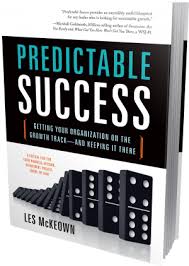 I recently finished the book Predictable Success: Getting Your Organization on the Growth Track-And Keeping It There by Les McKeown. The book is written for marketplace leaders; however, there are a number of principles that certainly apply to any organization including churches. Here are some of the key thoughts that jumped out to me from my reading:
I recently finished the book Predictable Success: Getting Your Organization on the Growth Track-And Keeping It There by Les McKeown. The book is written for marketplace leaders; however, there are a number of principles that certainly apply to any organization including churches. Here are some of the key thoughts that jumped out to me from my reading:
- You have to define your action plan and then work your plan. The win happens when “you can set (and consistently achieve) your goals and objectives with a consistent, predictable degree of success.”
- Healthy plans begin by identifying your “customers” and your customer’s needs. “Plan to start your business in ‘listen’ mode—you’ll find out where your customers are by asking, not by talking.”
- You have to establish systems to overcome the complexity created with growth. “The whole purpose of systems and processes is to enable an organization to deal effectively with complexity.”
- You have to balance the tension between risk and systems. “Predictable Success is achieved by introducing and maintaining the right amount of systems and processes necessary to tame complexity, while at the same time holding in balance the entrepreneurial zeal, creativity and risk taking that have grown the business to this point.”
- When maintaining current systems (methods or traditions) becomes the priority, the tendency is to also begin to focus inward. “Too many systems and processes in an organization cause it to slow down and lose its flexibility, and lead it to look inward rather than outward.”
- Ignoring the need to refresh vision and embrace changes will push people away who would naturally lead those efforts. “If Treadmill continues for any length of time (certainly more than a year), the more entrepreneurial people in the organization begin to leave, taking with them the organization’s ability to be (and interest in being) creative and visionary.”
- Complexity makes it difficult to make decisions and get things done. “Making and executing decisions is much harder in a complex organization than it is in a simple one.”
- To build a healthy organization, you have to remove emotion from staffing and structure decisions. “Separate the positions from the people, and concentrate on the positions.”
- Healthy leadership is more about what you give away than what you control. “Those managers who see their role as authority-based rather than leadership-based may resist emerging ownership and self-accountability in their direct reports because it appears (to them at least) to erode their own position by reducing their team members’ reliance on them.”
- Hiring only from within is one characteristic of organizations that find themselves in decline. “Organizations in Treadmill often emphasize a ‘we hire from within’ policy.”
Have you read this book? If so, share some of the highlights from your reading in the comments.







Leave a Reply